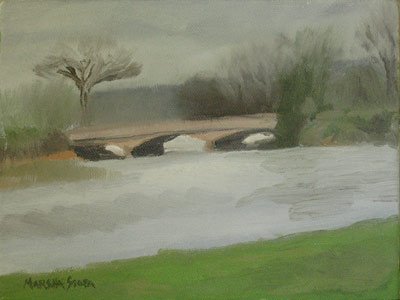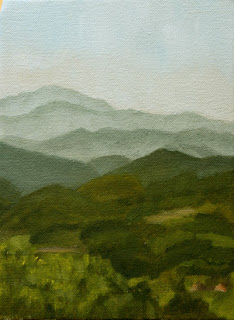Behind the house and the black walnut was a collapsed old barn, dropped by a powerful straight-line wind that blew through the area about 4-5 years ago. And hidden from sight beyond the barn wreck and assorted other dilapidated farm buildings was a beautiful little pond and a wide open grass field backed by woods. When I came back the next weekend, the fall colors were waiting.
It was about the last warm, sunny Sunday in mid-October and I was almost giddy to be out painting such a simple but lovely landscape. There were lots of greens to challenge me, along with more yellows than usual, plus some fabulous reds. I had to hold myself back on the reds -- I think we're so thrilled to see them in the fall that we think they look redder than they are.
 Overall, I'm pleased with the way this piece turned out. I like the variation of blue and white in the sky and the way the leafless trees fade out above the rest of the woods. I was able to capture the grasses and shrubs around the pond, as well as the reflections.
Overall, I'm pleased with the way this piece turned out. I like the variation of blue and white in the sky and the way the leafless trees fade out above the rest of the woods. I was able to capture the grasses and shrubs around the pond, as well as the reflections.For whatever reason, this is an area of southeast Michigan I haven't explored. It wasn't far from home, around 30 minutes by freeway on a Sunday, but I had no idea there are horse farms so close to the metropolitan area. Shame on me. While there are no horses on the old farm my friend lives on, there is a Morgan farm next door and several others on the half-mile or so back to the main road.
 After finishing the first, I turned around and focused on the barn next door that belongs to the landlord. I'm not sure if it's in use but it didn't look neglected. I was attracted by the orange leaves behind the red barn and the interesting shadow play on the grass in the foreground. This view presented numerous challenges: The pine tree in front of the orange tree on the right, the sinuous shadows on the bright sunlit grass and the skeleton of the leafless tree in the background.
After finishing the first, I turned around and focused on the barn next door that belongs to the landlord. I'm not sure if it's in use but it didn't look neglected. I was attracted by the orange leaves behind the red barn and the interesting shadow play on the grass in the foreground. This view presented numerous challenges: The pine tree in front of the orange tree on the right, the sinuous shadows on the bright sunlit grass and the skeleton of the leafless tree in the background.At this point it was getting close to late afternoon and I was going to lose this great light soon. I did the barn first, then put in the orange trees, then the green tree and shrub on the left, then the shadows in front. The leafless tree was one of the last areas I painted.
Now that I've had a few weeks to look at this one, there are some areas that don't satisfy me -- the leafless tree in the background looks too cumbersome and the green pine on the right needs more form. I'm also not too sure about the short side of the barn; I think the back corner needs to recede more to be more believable. I'm also still deciding if the shadows in the foreground work as well as they could. Nonetheless, a very satisfying afternoon. What is it Radar would have said in M*A*S*H --"slaked."
Let me know what you think. I've changed the requirements in the Comment box so you don't have to have a Google account to leave a comment. And I've added Feedburner, so this blog is available as a feed sent to you as it's updated. Feedburner also reformats the posts so that they are more readable by search engines, which in theory, could generate more traffic. We'll see!








